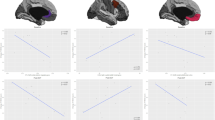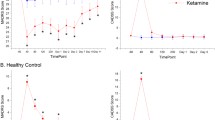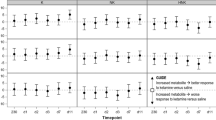Abstract
Rationale
High placebo response rates are a confound in treatment trials for major depressive disorder (MDD). A method for prospective identification of placebo responders could enhance the efficiency of clinical trials.
Objective
The objective was to identify the neurophysiological, symptomatic, and cognitive characteristics of subjects who were likely to respond to placebo in clinical trials for MDD.
Methods
Fifty-one subjects with MDD were treated in clinical trials with either fluoxetine (n=24) or venlafaxine (n=27) versus placebo. All subjects underwent pretreatment assessment with quantitative electroencephalographic (QEEG) power and cordance, as well as symptom ratings and neuropsychological testing. After a 1-week single-blind placebo lead-in, subjects were randomized to double-blind placebo controlled treatment with a medication or placebo. At the end of 8 weeks, the blind was broken and treatment response assessed. Response was defined by a final Hamilton Depression Rating Scale score of ≤10.
Results
Of the medication-treated and placebo-treated subjects, 52% (13/25) and 38% (10/26) responded. Placebo responders had lower pretreatment frontocentral cordance in the theta frequency band than all other subjects (P<0.006) and medication responders in particular (P<0.004). Placebo responders also had faster cognitive processing time, as assessed by neuropsychological testing, and lower reporting of late insomnia (P<0.03). Exploratory examination of a multiple variable model for predicting placebo response was conducted using logistic regression, in which these three pretreatment measures accurately identified 97.6% of eventual placebo responders.
Conclusions
These findings suggest that combined clinical, neurophysiological, and cognitive assessments of prospective subjects for clinical trials may be useful for identifying MDD subjects who are likely to show robust response to placebo. Prospective validation of these results in a larger, independent sample of subjects is necessary to establish the reliability and usefulness of this method for prospective identification of placebo responders.


Similar content being viewed by others
References
Alexopoulos GS, Meyers BS, Young RC, Kalayam B, Kakuma T, Gabrielle M, Sirey JA, Hull J (2000) Executive dysfunction and long-term outcomes of geriatric depression. Arch Gen Psychiatry 57:285–290
Asada H, Fukuda Y, Tsunoda S, Yamaguchi M, Tonoike M (1999) Frontal midline theta rhythms reflect alternative activation of prefrontal cortex and anterior cingulate cortex in humans. Neurosci Lett 274:29–32
Beecher HK (1955) The powerful placebo. JAMA 159:1602–1606
Benton AL (1968) Differential behavioral effects in frontal lobe disease. Neuropsychologia 6:53–60
Benton AL, Varney NR, Hamsher KD (1978) Visuospatial judgment. A clinical test. Arch Neurol 35:364–367
Brenner RP, Ulrich RF, Reynolds CF (1995) EEG spectral findings in healthy elderly men and women—sex differences. EEG Clin Neurophys 94:1–5
Cook IA, O’Hara R, Uijtdehaage S, Mandelkern M, Leuchter AF (1998) Assessing the accuracy of topographic EEG mapping for determining local brain function. EEG Clin Neurophys 107:404–414
Cook IA, Leuchter AF, Witte E, Abrams M, Uijtdehaage SHJ, Stubbeman W, Rosenberg-Thompson S, Anderson-Hanley C (1999) Neurophysiologic predictors of treatment response to fluoxetine in major depression. Psychiatry Res 85:263–273
Dunkin JJ, Leuchter AF, Cook IA, Kasl-Godley JE, Abrams M, Rosenberg-Thompson S (2000) Executive dysfunction predicts nonresponse to fluoxetine in major depression. J Affect Disord 60:13–23
Enserlink M (1999) Psychopharmacology: can the placebo be the cure? Science 284:238–240
Faries DE, Heiligenstein JH, Tollefson GD, Potter WZ (2001) The double-blind variable placebo lead-in period: results from two antidepressant clinical trials. J Clin Psychopharm 21:561–568
Fava M, Evins AE, Dorer DJ, Schoenfeld DA (2003) The problem of the placebo response in clinical trials for psychiatric disorders: culprits, possible remedies, and a novel study design approach. Psychother Psychosom 72:115–127
Hamilton M (1960) A rating scale for depression. J Neurol Neurosurg Psychiatry 23:56–62
Ishii R, Shinosaki K, Ukai S, Inouye T, Ishihara T, Yoshimine T, Hirabuke N, Asada H, Kihara T, Robinson SE, Takeda M (1999) Medial prefrontal cortex generates frontal midline theta rhythm. Neuroreport 10:675–679
Kaplan E, Goodglass H, Weintraub S (1983) Boston Naming Test. Lea & Febiger, Philadelphia, PA
Landin R, DeBrota DJ, DeVries TA, Potter WZ, Demitrack MA (2000) The impact of restrictive entry criterion during the placebo lead-in period. Biometrics 56:271–278
Leuchter AF, Newton TF, Cook IA, Walter DO, Rosenberg-Thompson S, Lachenbruch PA (1992) Changes in brain functional connectivity in Alzheimer’s-type and multi-infarct dementia. Brain 115:1543–1561
Leuchter AF, Cook IA, Lufkin RB, Dunkin J, Newton TF, Cummings JL, Mackey K, Walter D (1994a) Cordance: a new method for assessment of cerebral perfusion and metabolism using quantitative electroencephalography. Neuroimage 1:208–219
Leuchter AF, Cook IA, Mena I, Dunkin J, Cummings JL, Newton T, Migneco O, Lufkin R, Walter D, Lachenbruch P (1994b) Assessment of cerebral perfusion using quantitative EEG cordance. Psychiatry Res Neuroimaging 55:141–152
Leuchter AF, Uijtdehaage SH, Cook IA, O’Hara R, Mandelkern M (1999) Relationship between brain electrical activity and cortical perfusion in normal subjects. Psychiatry Res Neuroimaging 90:125–140
Leuchter AF, Cook IA, Witte EA, Morgan M, Abrams M (2002) Changes in brain function of depressed subjects during treatment with placebo. Am J Psychiatry 159:122–129
Lezak MD (1983) Neuropsychological Assessment. Oxford University, New York
Mayberg HS, Brannan SK, Mahurin RK, Jerabek PA, Brickman JS et al (1997) Cingulate function in depression: a potential predictor of treatment response. Neuroreport 8:1057–1061
McGrath PJ, Stewart JW, Petkova E, Quitkin FM, Amsterdam JD, Fawcett J, Reimherr FW, Rosenbaum JF, Beasley CM Jr (2000) Predictors of relapse during fluoxetine continuation or maintenance treatment of major depression. J Clin Psychiatry 61:518–524
Michelson D, Holland P, Tepner R, Pemberton C (1999) Double-blind vs. single-blind placebo lead-in periods during panic disorder efficacy trials. Poster presented at the 39th Annual NCDEU Meeting. Boca Raton, FL
Peselow ED, Sanfilipo MP, Difiglia C, Fieve RR (1992) Melancholic/endogenous depression and response to somatic treatment and placebo. Am J Psychiatry 159:1848–1854
Quitkin FM (1999) Placebos, drug effects and study design: a clinician’s guide. Am J Psychiatry 156:829–836
Quitkin FM, Stewart JW, McGrath PJ (1993) Columbia atypical depression. A subgroup of depressives with better response to MAOI than to tricyclic antidepressants or placebo. Br J Psychiatry 163:30–34
Reimherr FW, Ward MF, Byerley WF (1989) The introductory placebo washout: a retrospective evaluation. Psychiatry Res 30:191–199
Reitan RM (1958) Validity of the trail making test as an indicator of organic brain damage. Percept Mot Skills 8:271–276
Rey A (1941) L’examen psychologique dans les cas d’encephalopathie traumatique. Arch Psychol 28:286–340
Rey A (1964) L’examen clinique en psychologie. Pressess Universitiaires de France, Paris
Robinson DS, Rickels K (2000) Concern about clinical drug trials. J Clin Psychopharmacol 20:593–596
Shapiro AK, Shapiro E (1997) The Powerful Placebo: from Ancient Priest to Modern Physician. Johns Hopkins University, Baltimore
Stewart JW, Quitkin FM, McGrath PJ, Amsterdam J, Fava MD, Fawcett J, Reimherr F, Rosenbaum J, Beasley C, Roback P (1998) Use of pattern analysis to predict differential relapse of remitted patients with major depression during one year of treatment with fluoxetine or placebo. Arch Gen Psychiatry 55:334–343
Stroop JR (1935) Studies of interference in serial verbal reactions. J Exp Psychol 12:643–662
Stuss DT, Ely P, Hugenholtz H, Richard MT, LaRochelle S, Poirier CA, Bell I (1985) Subtle neuropsychological deficits in patients with good recovery after closed head injury. Neurosurgery 17:41–47
Thase ME, Simons AD, Reynolds CF (1993) Psychobiological correlates of poor response to cognitive behavior therapy: potential indications for antidepressant pharmacotherapy. Psychopharmacol Bull 29:293–301
Trivedi MH, Rush H (1994) Does a placebo run-in or a placebo treatment cell affect the efficacy of antidepressant medications? Neuropsychopharmacology 11:33–43
Ulrich G, Renfordt E, Zeller G, Frick K (1984) Interrelation between change in the EEG and psychopathology under pharmacotherapy for endogenous depression: a contribution to the predictor question. Pharmacopsychiatry 17:178–183
Ulrich G, Haug HJ, Fahndrich E (1994) Acute versus chronic EEG effects in maprotiline- and in clomipramine-treated depressive inpatients and the prediction of therapeutic outcome. J Affect Disord 32:213–217
Walsh BT, Seidman SN, Sysko R, Gould M (2002) Placebo response in studies of major depression: variable, substantial and growing. JAMA 287:1840–1847
Wechsler D (1981) Manual for the Wechsler Adult Intelligence Scale—revised. Psychological Corporation, New York
Wechsler D (1987) Manual for the Wechsler Memory Scale—revised. Psychological Corporation, New York
Woodcock RW, Johnson MB (1977) Woodcock-Johnson Psycho-Educational Battery. DLM Teaching Resources, Allen, Texas
Zimbroff DL, Mendez, G (2002) Patient and rater education about expectations in clinical trials (PREECT): an approach to reducing placebo response rates and improving signal detection in psychopharmacology trials. Poster presented at the 42nd Annual NCDEU Meeting. Boca Raton, FL
Acknowledgments
This work was supported by Research Scientist Development Award K02-MH01165 and grant R01-MH40705 from the National Institute of Mental Health to Dr Leuchter, and Career Development Award K08-MH01483 from the National Institute of Mental Health to Dr Cook. We also wish to acknowledge the grant support of Eli Lilly and Company, Inc. and Wyeth-Ayerst Laboratories, Inc. in conducting this study.
Author information
Authors and Affiliations
Corresponding author
Additional information
From the Laboratory of Behavioral Pharmacology, UCLA Neuropsychiatric Institute, and the Department of Psychiatry and Biobehavioral Sciences, David Geffen School of Medicine at UCLA, Los Angeles, CA.
Rights and permissions
About this article
Cite this article
Leuchter, A.F., Morgan, M., Cook, I.A. et al. Pretreatment neurophysiological and clinical characteristics of placebo responders in treatment trials for major depression. Psychopharmacology 177, 15–22 (2004). https://doi.org/10.1007/s00213-004-1919-2
Received:
Accepted:
Published:
Issue Date:
DOI: https://doi.org/10.1007/s00213-004-1919-2




